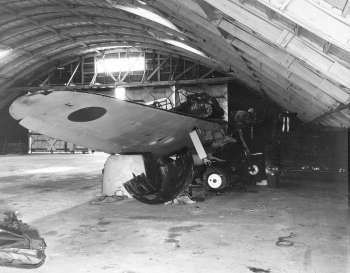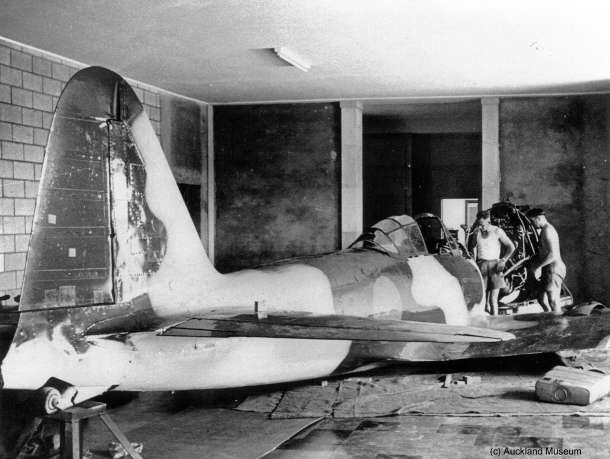Mitsubishi A6M Reisen
'Zero'
Aircraft Series

All text material on this site is
© Peter Lewis
1985, 1999
unless otherwise acknowledged

The Lean Years
By May 1946 all enthusiasm for the Zero had drained away,
and on the 6th of that month Air Department notified Hobsonville that
the Air Staff had decided to permanently ground NZ6000. The airframe
and engine were to be converted to instructional and held for the purposes
of demonstration and exhibition only. The airframe was allotted serial
number INST.113, the engine INST.BI72. This was done with effect from
8 May 1946, But initially the aircraft was placed in storage, not being
transferred to the Technical Training School, also at Hobsonville, until
28 February 1947.
It was never used for its designated purpose, and lay in a corner of
the TTS, tyres going flat and the aircraft in the way of men and other
machines. Finally, patience at an end, permission from Air Department
was sought on 21 August 1947 to dispose of it. Possibly as an incentive
to this end, the idea was first mooted that it had some value as a war
prize for display and should be offered to a museum.
This idea struck a chord, and the Air Member for Supply, Group Captain
C E Kay, wrote to the Department of Internal Affairs of 18 September,
asking if the War Memorial Museum at Auckland would be interested, as
transport to other museums out of Auckland would be a problem. After
some correspondence, Dr. Archie of the Museum accepted the aircraft
but asked that, due to the dimensions of the machine, it be kept at
Hobsonville until the necessary space could be provided. It was therefore
arranged that this be done, provided that delivery would be made as
soon as space was available; the RNZAF would deliver the aircraft as
an outright gift.
Hobsonville kept the aircraft for some years, but their patience grew
thin. By the early 1950s it was parked in the open with other old surplus
aircraft - the Seafire XV, some Sunderland IIIs, and several Catalinas.
Vandals, children and souvenir hunters removed fittings and instruments.
In April 1953 the Government Stores Board proposed that it be included
in the sale of surplus material held on the station, provided that the
aircraft was surplus. By pure chance, someone remembered that the Zero
had been promised to the museum, although the relevant file could not
be found. Thus it was saved from the melting pot to corrode for several
more years. The Museum was reminded  of
its possession, and again advised that until completion of the new wing
to its building, the aircraft could not be fitted in.
of
its possession, and again advised that until completion of the new wing
to its building, the aircraft could not be fitted in.
The only movements undertaken by the aircraft during the mid-1950s was
display at the Easter Shows of 1954 and 1957. After the second of these
shows, the aircraft was finally stored indoors again, at Ardmore in
No.8 hangar, in a semi-dismantled condition.
With the 21st Anniversary of the formation of the RNZAF due at the end
of March 1958, a large display was planned by the Air Force with the
focus at Ohakea. One of the officers involved in the planning of this
display, Wing Commander John Rees, remembered the Zero being at Hobsonville
and decided to include it in the display. Accordingly, he dispatched
a small party of airmen to proceed to Auckland, and told them not to
return until they had the Zero. Collecting it from Ardmore, they returned
to Ohakea only a few days before the display commenced.
Despite disbelief in their ability to restore it to presentable condition
in the time available, they set to work on the neglected,  stripped
and corroded airframe. A plywood cover was fitted over the seat to disguise
the cockpit, and a 'head' was fixed to this. Temporary repairs were
needed to fill in the holes on the skin. It was then repainted in an
unusual and inaccurate colour scheme and placed on display, widely acclaimed
as one of the stars of the show.
stripped
and corroded airframe. A plywood cover was fitted over the seat to disguise
the cockpit, and a 'head' was fixed to this. Temporary repairs were
needed to fill in the holes on the skin. It was then repainted in an
unusual and inaccurate colour scheme and placed on display, widely acclaimed
as one of the stars of the show.
After the display, it was stored at Ohakea until taken to Whenuapai
airfield for further work on 30 November 1959 and then delivered to
the Museum in December 1959, twelve years after the original offer and
in far worse condition than in 1947. Assembly at the Museum premises
was performed by Air Force personnel, thus fulfilling the earlier promise.